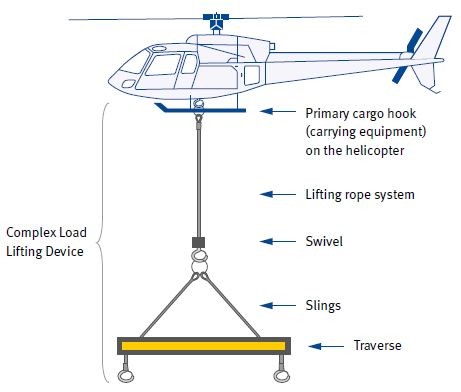Abschnitt 2 - 2 Terms and Definitions
2.1
Helicopter operations as defined in this information are business operations of helicopters for the application
purpose (category) "aerial work". The operations are designated as "occasional traffic"
(see Section 22 Air Traffic Act). These include especially:
photography and filming
agricultural operations
installation flights
timber transporting (logging)
measuring flights
flights with working basket
flights with persons outboard
banner towing
monitoring tasks
flights with fixed working seat in or on the helicopter
snowfield blasting
fire-fighting operations
2.2
Working materials are tools, devices, machines or systems, such as, for example:
helicopters
ground support equipment for the helicopter
Load Lifting Devices
transport and loading vehicles
tools
means of communication
2.3
Load Lifting Devices are mounted between the helicopter's primary cargo hook and the load, to enable their
lifting. These include for example:
lifting rope systems with fittings
slinging equipments and their components
shock absorbers
swivels
remote cargo hooks
| Complex Load Lifting Device |
|---|
 |
The following can again be attached to Load Lifting Devices, e.g.:
power-driven concrete buckets
traverses
special lifting lugs
ready-to-use chains and their components
FIBC (Flexible Intermediate Bulk Container, "Big Bag")
2.4
Slinging equipments are used to fasten (attach) the load and are normally attached in the secondary cargo
hook using appropriate swivels. Slinging equipments and their components are classified
as Load Lifting Devices. The following are used as slinging equipments:
slinging ropes
lifting straps
round slinging equipments
sling chains
multiple leg suspension gear (2-, 3- or 4-leg)
detachable connecting parts (e.g. shackles, round sling hooks)
short choker steel ropes for logging
2.5
Primary cargo hooks on the helicopter are connected to the helicopter and used to accept Load Lifting
Devices or a direct load (e.g. fire extinguishing water containers - Bambi Bucket).
The permitted load capacity of the primary cargo hook (Working Load Limit, WLL) is
one of the limiting features of a helicopter.
2.6
Lifting rope system is the part of the Load Lifting Devices that is used between primary cargo hook and
load or slinging equipments.
2.7
Personnel Carrying Device Systems (PCDS) are devices or (carrying) systems with structural features that are required
for the transport of persons as external loads on the helicopter (Human External Cargo,
HEC) in the context of operations. These are, in particular:
working cages,
platforms and
rope systems with Personal Protective Equipment against falling for persons with and without working seats.
2.8
Technical fittings of the helicopter are working fixtures and fittings in or on the helicopter that
are necessary for the execution of the respective types of operation and equipped
with a Supplementary Type Certificate (STC). These include, e.g.:
primary cargo hook
attachment points on the skid bases
load cell with indication
facilities to observe the external cargo, such as for example:
cameras
mirrors
bubbles
2.9
Other working materials are necessary working materials for the respective type of assignment without load-bearing
function, such as, for example:
lashing belts
holding and guiding ropes
hook clamps
packaging film
assembly aids
2.10
Employer is the respective natural or legal person, where the economic outcome of the company
turns out to be immediately to his advantage or disadvantage.
2.11
A Responsible Person can be entrusted with the management of a sector of the company or within the scope
of the tasks and powers assigned to him for a helicopter operation by the employer.
2.12
Insured individuals as defined in this information are all persons, who enjoy the protection of the statutory
accident insurance.
2.13
A Head of Operations is a person, who is entrusted by the employer to manage the respective working operation
within the scope of the tasks and powers assigned to him/her.
2.14
A Marshaller is a trained person with special tasks on board or on the ground within the scope
of the respective type of task of the aerial work.
2.15
OSH Professional (OSH = Occupational Safety and Health) is a person with proven safety-related specialist knowledge appointed in writing
to advise the employer.
2.16
An Occupational Physician is a person with proven occupational medical specialist knowledge appointed in writing
to advise the employer.
2.17
Outside working stations are permanent or temporary, portable places of work for work operations, such as,
for example:
external take-off and external landing places
load pick-up and load drop-off places
refueling places
jettisoning and emergency landing places
